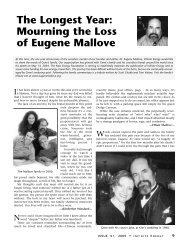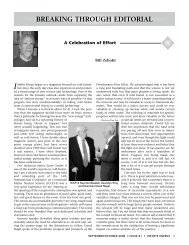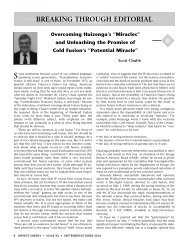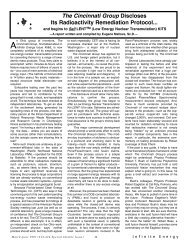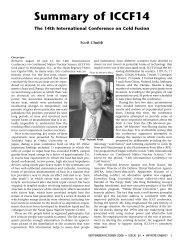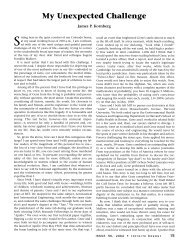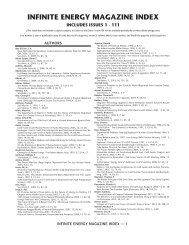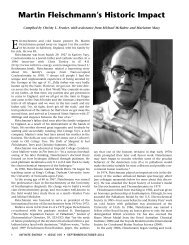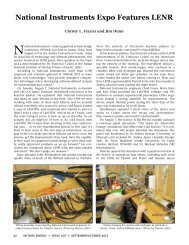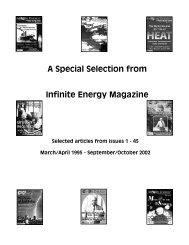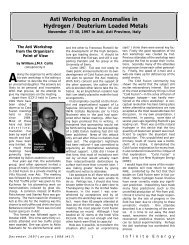MIT and Cold Fusion: A Special Report - Infinite Energy Magazine
MIT and Cold Fusion: A Special Report - Infinite Energy Magazine
MIT and Cold Fusion: A Special Report - Infinite Energy Magazine
You also want an ePaper? Increase the reach of your titles
YUMPU automatically turns print PDFs into web optimized ePapers that Google loves.
canard used by those who have tried to “wish away” many cases of<br />
experimentally determined excess heat: “Uncontrolled catalytic recombination<br />
of the oxygen <strong>and</strong> hydrogen produced gas is a source of possible<br />
excess power in the right range.” A number of excellent experiments<br />
have thoroughly investigated this “explanation” <strong>and</strong> have rejected it.<br />
Recombination is not a significant factor in open cell work. (In closedcell,<br />
deliberate recombination work, it is no factor at all, <strong>and</strong> there are<br />
excellent positive experiments of that kind too.) On the other h<strong>and</strong> <strong>and</strong><br />
to his great credit, Professor Morrison correctly notes, “It is possible that<br />
helium is lost from the cells.” Indeed, this is precisely the result that<br />
researchers at the Naval Weapons Center have recently reported in connection<br />
with their calorimetric work.<br />
There is a significant omission in Professor Morrison’s critique.<br />
Nowhere do I find an assessment of the validity of subtracting a “somewhat<br />
arbitrary linear function” from the raw heater power data to get<br />
net excess power. Dr. Morrison assumes a priori that the group<br />
employed a correct algorithm. But as my 18 August letter suggests, that<br />
methodology is completely incorrect.<br />
Professor Morrison accepts what I believe to be a gratuitous statement<br />
in Professor Parker’s hastily prepared letter to me of August 8,<br />
1991—the one I received on the eve of the WBUR radio broadcast—in<br />
which he tries to explain the apparent curve shift between July 10 <strong>and</strong><br />
July 13. Parker’s statement is: “In one, the drift was fitted with a somewhat<br />
arbitrary linear function. . . in the other, the drift was fitted with a<br />
different linear function, this time a least squares fit, <strong>and</strong> the data<br />
appearing in the final version of the paper were produced.” I do not<br />
think it is possible to accept this statement on its face. The light water<br />
curve has not been moved down by any new form of mathematical<br />
adjustment, but the heavy water curve most certainly has been moved.<br />
In fact, I believe that this statement about two methods of fitting the drift<br />
to be a complete fabrication on the part of Parker, much as his statements<br />
about what he did or did not say to Nick Tate are completely false.<br />
Professor Morrison is certainly correct that the July 13 draft results<br />
in an excess heat that is “visibly close to zero for both cells.” I do not<br />
contest that, for that is precisely what this curve shift was apparently<br />
intended to bring about. So, I must strenuously disagree with Professor<br />
Morrison’s statement, “Objectively, one has to say that the published<br />
paper does not mislead.” I believe to the contrary. The paper misleads<br />
most egregiously. Professor Morrison’s polite recommendation #3<br />
directly governs this matter: “They should also describe the two<br />
approaches to correction in more detail than the by-name-only account<br />
in the letter by Dr. Parker to Dr. Mallove of 8 August 1991.” In my view,<br />
there is very strong evidence that the alleged “two approaches” is really<br />
only one method of fitting the data <strong>and</strong> performing the forementioned<br />
inappropriate subtraction of the resulting fitted line. The second<br />
“approach” is merely data-averaging into one-hour samples <strong>and</strong> subsequent<br />
shifting of the curve down to give the impression of a null result.<br />
More evidence for my contention: If there really had been two methods<br />
of analysis applied to the data that would instantly explain the curve<br />
shift, why would not Professor Parker et al. have immediately shown<br />
me the two computer source codes or the notebook-written algorithms.<br />
This would have immediately cleared up at least the matter of the origin<br />
of the shift. Such was not done, I am quite certain, because two distinct<br />
approaches to the data processing did not exist.<br />
I do not believe that Professor Parker et al. can be trusted at this<br />
time to give forth a complete account of how that curve adjustment<br />
occurred. If asked to do so, they might contrive some kind of algorithm<br />
with a convenient free parameter or parameters that will show how<br />
they processed the data to get the two sets of results.<br />
In conclusion, <strong>and</strong> in regretted disagreement with the recommendations<br />
of Professor Morrison, I must again ask you to convene an<br />
appropriate panel to thoroughly explore scientific misconduct on the<br />
part of the <strong>MIT</strong> research group. When this panel renders its opinion, I<br />
am confident that it will reach the very conclusion about this experiment<br />
that Professor Parker publicly announced on June 7, 1991, <strong>and</strong><br />
later implicitly rejected, namely that it not “worth anything.” This is<br />
what he said <strong>and</strong> he will be held to his word that he believes the curves<br />
can be redrawn “anyway that you want”:<br />
“I’ll tell you what my opinion is of that work, because I was part of<br />
it. I don’t think it’s worth very much. Alright? And that’s why it’s just<br />
published in a tech report. I don’t think it’s worth very much. I think to<br />
do calorimetry is one of the hardest things I ever tried to do. I’d rather<br />
stick to plasma physics. . . When you have an open system is where you<br />
can make big errors, where you don’t know the overpotential, the electrode<br />
potential, <strong>and</strong> so on. These things are unknown. I mean it’s really<br />
tough <strong>and</strong> that’s why I don’t put any stock at all—you can redraw those<br />
curves anyway that you want. I don’t think that data is worth anything.”<br />
Rather than allow the PFC team members further opportunities to<br />
fiddle with their data, I recommend that all notebooks, computer files,<br />
<strong>and</strong> printed records relating to their experiment be immediately<br />
impounded <strong>and</strong> turned over to an investigative team for thorough<br />
analysis. I requested this inquiry in late August. It is now late October.<br />
Your letter to me in early September said that my material would be<br />
“appropriately reviewed during the coming several days.” Time<br />
enough has gone by in deliberations over what to do. It was a good, but<br />
not a sufficient course to ask Professor Morrison’s opinion, which he<br />
rendered the day after he received the material from you. However, it<br />
is now time to appoint a panel that will probe to the core of what I<br />
steadfastly believe to be evident scientific misconduct.<br />
Both you <strong>and</strong> others, especially Professor Morrison, should be<br />
under no illusion that my hope for cold fusion lies in extracting some<br />
evidence of excess heat from the PFC data. You should know that positive<br />
conclusions about cold fusion are based on a preponderance of evidence<br />
from elsewhere. After the results that will likely be discussed at<br />
the third annual conference on cold fusion in Nagoya, Japan, in the fall<br />
of 1992, no one will need the PFC’s ancient <strong>and</strong> discredited data. It will<br />
be past history, <strong>and</strong>, indeed, a very sorry history for <strong>MIT</strong>.<br />
The case of the PFC data concerns scientific ethics: Is it permissible<br />
to massage data to one’s taste—to artificially present a strong negative<br />
impression rather than an ambiguous <strong>and</strong> possibly positive one? I think<br />
not. I do not deny the PFC group the right to discuss the sensitivity of<br />
their experimental measurement <strong>and</strong> then to suggest that because of that<br />
sensitivity their result should be read as null. But it was clearly inappropriate<br />
to arbitrarily shift processed data to contrive a “desired appearance”<br />
<strong>and</strong> not let the viewers of their report form their own judgements.<br />
And do not forget my contention that the very basis for arriving at the<br />
original processed data (before the shift) is, in any event, not correct. At<br />
the very least, the paper requires substantial revision on that account.<br />
Until I am persuaded by strong technical arguments that deliberate<br />
curve-shifting has not occurred, <strong>and</strong> that an appropriate processing of<br />
the data has been applied, I will continue to believe in the need for a<br />
thorough investigation. I appreciate Professor Morrison’s offer to discuss<br />
the content of his memor<strong>and</strong>um with me, however at this time I do<br />
not feel a need for that kind of discussion. The discussion I <strong>and</strong> several<br />
of my colleagues would respectfully like to have with him would be to<br />
discuss the overwhelming ancillary evidence for cold fusion, not the<br />
PFC paper. I underst<strong>and</strong> his contentions about the PFC work very well<br />
<strong>and</strong> do not need clarification. I look forward to your reply about the<br />
next steps that you will take.<br />
Sincerely, Eugene F. Mallove<br />
Exhibit Y<br />
Eugene Mallove’s Letter to President Charles Vest<br />
December 31, 1991<br />
Over two months have gone by <strong>and</strong> still no action has been<br />
taken on my request for a full investigation.—EFM<br />
President Charles M. Vest, <strong>MIT</strong> Room 3-208<br />
Dear Dr. Vest:<br />
My last letter to you regarding the progress of the <strong>MIT</strong> misconduct<br />
investigation was on 24 October. With the exception of a subsequent<br />
telephone message from Ms. Laura Mersky stating that you considered<br />
the investigation to be a matter of high priority, which you would<br />
attend to upon returning from a foreign trip, I have received no communication<br />
from you. Would you kindly let me know what actions<br />
have been taken?<br />
I can assure you that in 1992 there will be many developments<br />
regarding cold fusion, both scientific <strong>and</strong> governmental. It will accordingly<br />
be imperative to resolve the <strong>MIT</strong> misconduct matter as soon as<br />
possible. I look forward to your early reply.<br />
Sincerely, Eugene F. Mallove<br />
49 <strong>Infinite</strong> <strong>Energy</strong> • ISSUE 24, 1999 • <strong>MIT</strong> <strong>Special</strong> <strong>Report</strong>



